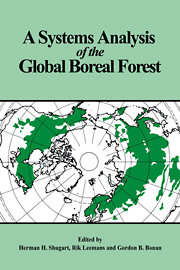Book contents
- Frontmatter
- Contents
- List of contributors
- 1 Introduction
- Part 1 Processes in boreal forests
- Part 2 Patterns in space and time in boreal forests
- Part 3 Computer models for synthesis of pattern and process in the boreal forest
- Introduction
- 12 Individual-tree-based models of forest dynamics and their application in global change research
- 13 Population-level models of forest dynamics
- 14 A spatial model of long-term forest fire dynamics and its applications to forests in western Siberia
- 15 A simulation analysis of environmental factors and ecological processes in North American boreal forests
- 16 The biological component of the simulation model for boreal forest dynamics
- 17 Role of stand simulation in modeling forest response to environmental change and management interventions
- 18 Concluding comments
- References
- Index
16 - The biological component of the simulation model for boreal forest dynamics
Published online by Cambridge University Press: 12 January 2010
- Frontmatter
- Contents
- List of contributors
- 1 Introduction
- Part 1 Processes in boreal forests
- Part 2 Patterns in space and time in boreal forests
- Part 3 Computer models for synthesis of pattern and process in the boreal forest
- Introduction
- 12 Individual-tree-based models of forest dynamics and their application in global change research
- 13 Population-level models of forest dynamics
- 14 A spatial model of long-term forest fire dynamics and its applications to forests in western Siberia
- 15 A simulation analysis of environmental factors and ecological processes in North American boreal forests
- 16 The biological component of the simulation model for boreal forest dynamics
- 17 Role of stand simulation in modeling forest response to environmental change and management interventions
- 18 Concluding comments
- References
- Index
Summary
Introduction
The extent of the circumpolar boreal forest strongly corresponds to macroclimate. Within its climatic limits, the system functions as a complex interrelation between solar radiation, soil moisture, the forest floor organic layer, nutrient availability, forest fires, insect outbreaks and vegetation patterns (Bonan & Shugart 1989). Bonan (1989a and Chapter 15 of this volume) has specified a model for the environmental regimes, which sets the limits driving boreal forest dynamics. He has linked this model with a forest succession model, a gap model, which simulates the demographic processes of tree populations through time within the environmental constraints, and a model of moss dynamics. The combined model mimics the large-scale dynamics of boreal forest (Bonan 1989a; Bonan & Korzukhin 1989).
Bonan's model simulated different stands well with respect to species composition, biomass and density. The ability to simulate such trends in quantitative characteristics of tree species is a robust feature of gap models in general (Shugart 1984; Leemans & Prentice 1987). This robustness is largely a result of the coupling of growth responses of individual trees to environmental factors. If the annual growth of a tree declines as a result of environmental conditions, its chances of dying increase. Thus, the individual tree is removed from the plot, leaving room for better-adapted individuals. This aspect of the traditional gap models appears to provide a robust ability to reproduce composition, biomass and density. If more precisely defined forest structures are used to test such models, the models are often less successful.
- Type
- Chapter
- Information
- A Systems Analysis of the Global Boreal Forest , pp. 428 - 445Publisher: Cambridge University PressPrint publication year: 1992
- 9
- Cited by



